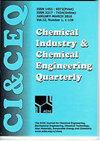Comparison of corrosion behaviour of copper and copper alloys in aqueous chloride solution
IF 0.8
4区 工程技术
Q4 CHEMISTRY, APPLIED
Chemical Industry & Chemical Engineering Quarterly
Pub Date : 2021-01-01
DOI:10.2298/CICEQ200701007G
引用次数: 6
Abstract
A comparative corrosion study of Cu and Cu-Al, Cu-Al-Ni, Cu-Al-Mn, and Cu-Al-Mn-Ni in 0.5 mol dm-3 NaCl solution was performed using an open circuit potential, potentiodynamic polarization, and electrochemical impedance spectroscopy measurements (EIS). Scanning electron microscopy/Energy-dispersive X-ray spectroscopy (SEM/EDS) analysis was used to evaluate corrosive damage on the sample surface after polarization measurements. The reported results suggest that the alloying elements have reduced cathodic and anodic current densities in the Tafel region, increased anodic currents at higher anodic potentials, and slightly displaced corrosion potential towards more positive values. Overall, impedance increases in the following order: Cu < Cu-Al < Cu-Al-Ni < Cu-Al-Mn < Cu-Al-Mn-Ni. This indicates that Cu alloys possess better corrosion resistance. SEM and EDS analysis after polarization measurements showed uniform dissolution of pure Cu, as well as the presence of a surface oxide layer, consisting of a mixture of the corresponding alloying elements, on all investigated alloys. Aggressive anodic polarization severely damaged the barrier layers on the Cu alloy specimens.铜和铜合金在氯化物水溶液中的腐蚀行为比较
利用开路电位、动电位极化和电化学阻抗谱测量(EIS)对Cu和Cu- al、Cu- al - ni、Cu- al - mn和Cu- al - mn - ni在0.5 mol dm-3 NaCl溶液中的腐蚀进行了比较研究。利用扫描电镜/能谱分析(SEM/EDS)对极化测量后样品表面的腐蚀损伤进行评价。结果表明,合金元素降低了Tafel区的阴极和阳极电流密度,在较高的阳极电位下增加了阳极电流,并使腐蚀电位向更正的方向偏移。总体而言,阻抗的增加顺序为:Cu < Cu- al < Cu- al - ni < Cu- al - mn < Cu- al - mn - ni。这说明Cu合金具有较好的耐蚀性。极化测量后的SEM和EDS分析表明,纯Cu均匀溶解,并且在所研究的合金上存在由相应合金元素混合物组成的表面氧化层。侵略性阳极极化严重破坏了Cu合金试样上的阻挡层。
本文章由计算机程序翻译,如有差异,请以英文原文为准。
求助全文
约1分钟内获得全文
求助全文
来源期刊

Chemical Industry & Chemical Engineering Quarterly
CHEMISTRY, APPLIED-ENGINEERING, CHEMICAL
CiteScore
2.10
自引率
0.00%
发文量
24
审稿时长
3.3 months
期刊介绍:
The Journal invites contributions to the following two main areas:
• Applied Chemistry dealing with the application of basic chemical sciences to industry
• Chemical Engineering dealing with the chemical and biochemical conversion of raw materials into different products as well as the design and operation of plants and equipment.
The Journal welcomes contributions focused on:
Chemical and Biochemical Engineering [...]
Process Systems Engineering[...]
Environmental Chemical and Process Engineering[...]
Materials Synthesis and Processing[...]
Food and Bioproducts Processing[...]
Process Technology[...]
 求助内容:
求助内容: 应助结果提醒方式:
应助结果提醒方式:


